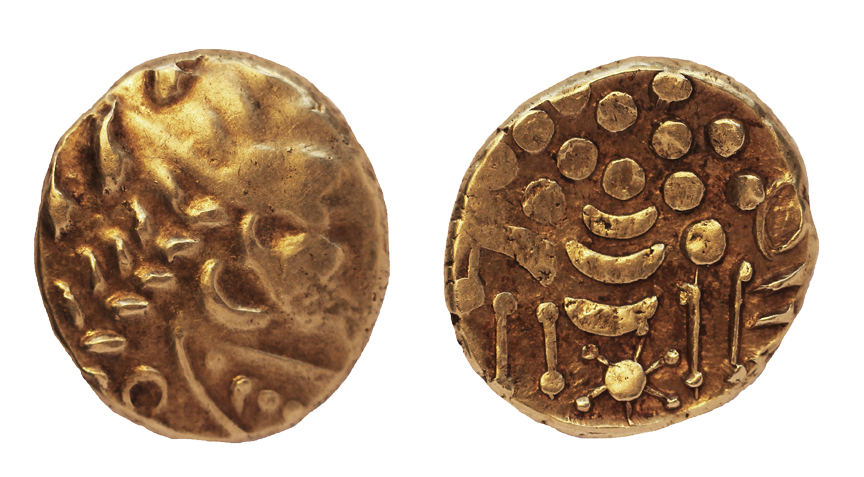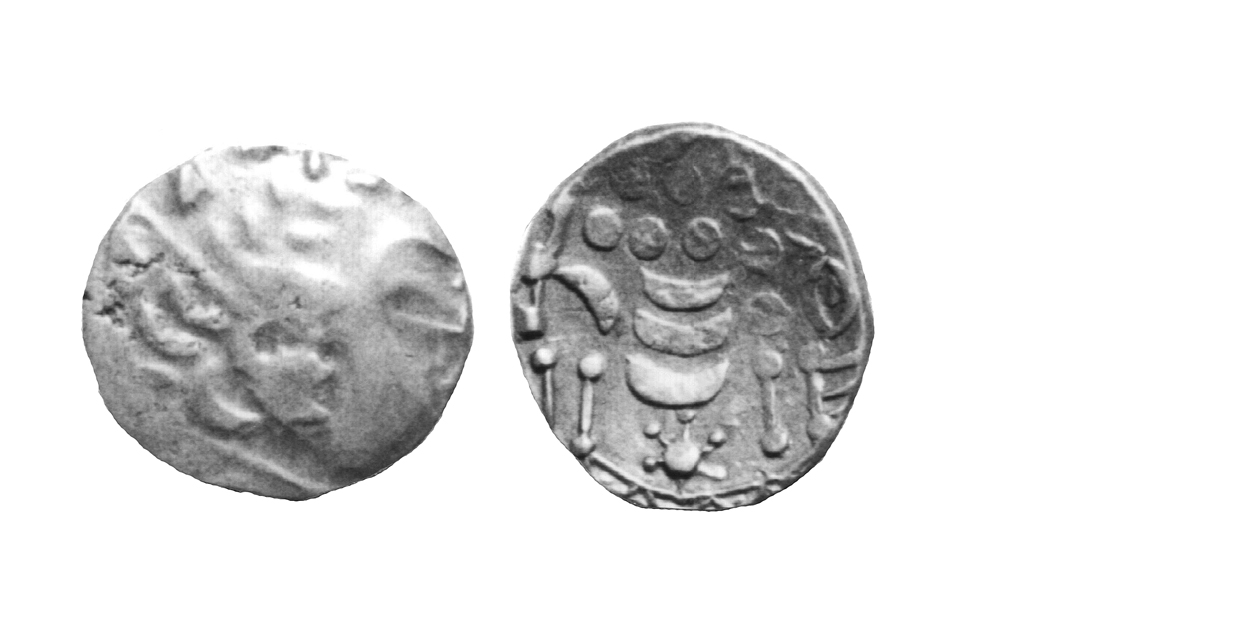
About the Coins
Art – Introduction (Info)
Celtic Coins and Celtic Art
Celtic coins look the way they do because that's exactly the way the Celts wanted them to look. The imagery, no matter how incredible it may appear at first, is not due to lack of ability. Expert die cutters rose to practice their craft in Britain just as they did in Greece or Rome. Look at an Atrebatic Abstract Type stater under magnification and you see expert die-cutting – craftsmen working with steady hands and keen eyes. The Celts were creating exactly the images they wanted.
Although many Celtic images are derived from classical Greek and Roman prototypes, they seldom look as the originals do. In the past, they have been described as barbarous copies; lack of die-cutting skill accounting for the imperfect reproduction. But this view is clearly an uninformed one because the differences are predictable the result of conscious preference. Celtic coins are consistently more abstract, more expressionistic than the Classical prototypes. Instead of copies, they represent adaptations of the Classical images ideas borrowed from the Greeks or Romans, but adapted to the artistic tastes and preferences of Celtic society.
Abstraction and Expression
Celtic society preferred non-representational art. Producing an exact likeness of an object was unimportant, exact likenesses were undesirable most of the time. Instead, the artist tried to express some feeling about the object, for example the power and speed of a horse, or the fierce attack of a boar. Usually he did not depict the object as it appeared in real life, because a mirror-like representation could obscure the desired feeling. The Celts, understanding this, rejected the Classical art of Greece and Rome.
The Celts' abstract, expressionistic art best reveals itself in images of animals. Celtic society, with a large pastoral element, had an appreciation for the qualities of animals. On the early coins, for example, horses are reduced to stick-figures – but what stick-figures they are! The images are ones of power and grace, the animals bounding across the coins with legs straining for speed and tails flying in the wind. This desire to enhance the appreciation of things by reducing them to their simplest essentials is one of the powerful elements of pre-Roman Celtic art.
The creation of striking graphic designs was another. Much of Celtic art was decorative – images were used to decorate everyday objects such as pottery, swords and harness fittings. The goal was to create images that caught the eye and delighted the viewer. The images could be of an animal or human, but could, just as well, be an abstract design.
Pre-Roman Celtic art was seldom symmetrical, that is, one half of an image was not the mirror of the other. However, there was always asymmetric balance to the design in which the elements counterbalanced one another. The easiest way to appreciate this is to rotate an early coin and note how the design seems balanced and pleasing regardless of the orientation. The coin does not have to be viewed right-side-up to appreciate the excellent graphic design. Indeed, by mastering asymmetric balance, the Celts created some of the most striking graphic designs ever to appear on coins.
Conservatism, Copying and Adaption
There were, however, countervailing influences preventing the Celts from attaining a high level of artistic expression on every coin. Coins of high intrinsic value had to be accepted freely, or the coins became useless. Coin designs tended to be conservative as a result, and once an image became accepted on the coinage, it was recreated with minimal change on successive issues. It became an immobilized type. In such instances artistic expression was subjugated to economic necessity.
Furthermore, after the Gallic War, certain tribes in Britain were favoured by the Romans and were showered with Roman luxury goods. The Romans often used cultural conquest as a prelude to military invasion, softening-up the enemy prior to invasion. Thus, after the war, the Trinovantes/Catuvellauni and later the Atrebates/Regni/Belgae were subjected to Romanizing influences. These were to alter Celtic thought and attitudes, and the manifestations are seen on the coins. Although purely Celtic images never quite disappear, the percentage of tribal coins with Romanized images increases over time. In some isolated instances, simple copying of Roman images occurs, but on the majority of coins, adaptation occurs, that is, the Roman image receives a Celtic transformation. Significantly, the other tribes, having less direct contact with the Romans, tended to resist the intrusion of Roman stylistic elements on their coins.
Ornamentation
The images on Celtic coins almost never float freely in an uncluttered field. Instead, the field is normally filled with a myriad of small objects and abstract designs. Occasionally these are sub-designs, like a tiny boar beneath the horse or an ox head above it. But more often the objects are rings, pellets, crosses or floral patterns. Some of these images are added merely to decorate the available space, and present the viewer with more things to discover as one looked at the coins.
Privy Marks
However, the Celts were a technologically astute people, especially in the area of metallurgy. Their coins were remarkably well-made and the moneyers gave particular attention to controlling weight and metallurgical content. As time went on, the tribes experienced inflation, especially during the Gallic War. As a countermeasure, they reduced the standard weights of the gold coins while simultaneously replacing the gold content with first silver and later, copper. These changes were made gradually and in a remarkably complex way – it must have been the intention to render them in an imperceptible manner. Some of the ornaments in the fields have been shown to be privy marks, placed there by the moneyers so they could identify the weight and metallurgical content of the coins by sight.
Propaganda
One Romanizing influence changed the coinage after the Gallic War – the proliferation of propaganda devices. Prior to the war, the designs on the coins were primarily immobilized types. If there was any political meaning intended, it has been largely lost in time. Some differences in ornamentation, and the choice of motifs, may have denoted tribal affiliation, but this is conjecture. After the war, however, the coinage becomes an important medium of propaganda. First, the names of rulers appear: Commius and Addedomaros, then later, the names of cities: Verulamium, Camulodunum and Calleva.
Tribal names may have been used, the ECE and ECEN on some Icenian silver pieces probably denote the name of the tribe. It appears tribal rivalries manifest themselves on the coins. The coins were being used for boasting, especially as expressions of economic prowess on the part of the powerful tribes.
Direct expressions of tribal accomplishments are more difficult to detect, but some were produced. The appearance of a victory on the coins of Eppillus in Kent probably commemorated the incursion of the Atrebates/Regni into Kent. This occurred after Tasciovanus left the Trinovantian/Catuvellaunian throne, creating a power vacuum in the southeast of Britain. The later appearance of victories on later Trinovantian/Catuvellaunian coins may have commemorated the reversal of the situation. Finally, the subsequent appearance of Trinovantian/Catuvellaunian designs on the coinage of the Atrebates/Regni/Belgae during the reign of Epaticcus chronicle the gradual encroachment of influence, and the subjection of the weaker tribe.
Next Section – Sources of Inspiration

